Prognosticating the Impact of Seasonal Variability on Microbial Load in Water Bodies Around Dhaka City, Bangladesh
| Received 20 Oct, 2023 |
Accepted 31 Jan, 2024 |
Published 23 Feb, 2024 |
Background and Objective: Surface water of different reservoirs in Bangladesh is often contaminated with biological, chemical and physical wastes. Increasing population, urbanization and industrialization are contributing to the situation. The study aimed to assess seasonal variations in microbial load in water bodies surrounding Dhaka City, Bangladesh. Materials and Methods: Two rivers (Turag and Burigonga) and lakes (Banani and Dhanmondi) in and around Dhaka City were selected for the current study. Spread plate techniques were conducted to obtain bacterial load in water samples. Total Viable Count (TVC), Total Coliform Count (TCC), Total Fecal Coliform Count (TFCC) and Total Salmonella Shigella Count (TSSC) were conducted as well and data were represented as CFU/mL in a log scale. Results: The majority of the water reservoir exhibited a declining bacterial load during winter whereas it is significantly high during spring. Major bacterial genera in the water bodies included in this study were Staphylococcus aureus, Micrococcus sp., E. coli, Salmonella sp., Shigella sp., Enterobacter sp., Pseudomonas sp., Acinetobacter sp., Proteus sp. and both river water and lake water harbored almost similar genera of bacteria. In general, there is a declining trend of microbial load (TVC CFU/mL; TCC CFU/mL; TFC CFU/mL and TSSC CFU/mL) in both types of water bodies around Dhaka City, Bangladesh. Conclusion: The current study implies that pathogenic isolates such as Escherichia coli, Salmonella sp., Enterobacter S. aureus, Klebsiella sp., Citrobacter sp., Shigella sp., Pseudomonas sp. can cause serious health issues if unsafe water from these reservoirs is used for day to day activity without treatment.
INTRODUCTION
Rivers and lakes act as the natural reservoirs of water for human and animal usage1. Polluted water reservoirs act as common habitats for pathogenic microorganisms related directly and indirectly to the feces of humans and warm-blooded animals. Depending on the purpose of use, type and the load of pathogens sanitary and public health threat levels may increase or decrease2,3. According to WHO/UNICEF in Bangladesh, 85 and 78% of urban and rural inhabitants respectively have access to improved drinking water sources4. The rest of the population can be found using unimproved drinking water sources such as dug wells, springs, tanker trucks and surface water including rivers, dams, lakes, ponds, streams, channels and irrigation channels5.
Water-borne diseases are the major cause of morbidity in many developing countries2,6. Globally more than 2.2 million deaths per year are estimated to be related to waterborne disease where around 1.4 million of mortality is observed in children7. Waterborne infections can be caused by contaminated water containing bacteria, viruses, protozoa and helminths8,9. Worldwide 780 million people lack a purified water source and 2.5 billion people lack improved sanitation10 causing 3.2% of deaths globally by consumption of water contaminated due to poor sanitation and hygiene11,12. According to WHO improving water quality can reduce the burden of global disease by approximately 4%4,13. Regular monitoring of surface water quality is necessary for both urban and rural areas for continuous government interference with obtained information from monitoring14,15.
Because of their diversity, scarcity and the time, expense and complexity involved in conducting such tests, it is not practical to microbiologically examine the number and quality of every pathogen2,16,17. While molecular methods are able to simultaneously identify several bacteria, they are expensive and unable to distinguish between pathogens that are living and those that are not18,19. Fecal coliform levels are the basis for ongoing water quality monitoring20. The 2 most widely utilized and recognized microbial markers at the moment are fecal coliforms (FC) and total coliforms (TC)21,22. The relationship between fecal coliform burden and illness risk has been the subject of numerous investigations conducted both in the past and in the present23-26.
Water-borne diseases consist of a quarter of all illnesses in Bangladesh27. However, there is a scarcity of available reports on surface water quality in Bangladesh. Present study included rivers: Burigonga and Turag as well as two man-made lakes, Banani and Dhanmondi. The primary objective of this investigation was to assess the microbiological quality of the water and identify any possible microorganisms that could be responsible for waterborne illnesses. In test water bodies, the impact of seasonal variations, microbial population analysis and future microbial load forecasting were also noted.
MATERIALS AND METHODS
Study area, sample collection and enrichment: The microbiological assessment of waters was performed from Spring 2017 to Monsoon, 2020. Samples were collected in a sterile container from 2 rivers: Turag and Burigonga and two lakes: Banani and Dhanmondi28. Samples were transported to the Center of Excellence for Global Health Research, Department of Microbiology, Primeasia University at the earliest convenience.
Total microbial load: To determine the microbial load in the present study, Total Viable Count (TVC), Total Coliform Count (TCC), Total Fecal Coliform Count (TFCC) and Total Salmonella Shigella Count (TSSC) were performed for each of the samples by spread plate count technique. Samples were serially diluted in ten-fold dilution using sterile saline. Post dilution 100 μL of diluted water samples were spread onto Plate count agar media (Oxoid, UK) for TVC, MacConkey agar media (Oxoid, UK) for TCC, MFC agar media (Oxoid, UK) for TFCC and SS agar media (Oxoid, UK) for TSSC. The plates were incubated at 37° except for MFC media plates which were incubated at 44.5°C up to 48 hrs. After incubation, CFU/mL were determined29. Microbial counts were converted into log scales to generate graphical representations.
Identification of specific bacteria: Isolated colonies from media plates were streaked on selective and differential agar media as MacConkey, MFC, SS, TCBS (Oxoid, UK), Cetrimide (Oxoid, UK), MSA (Oxoid, UK) and EMB agar media which were incubated overnight at 37°C and MFC were incubated at 44.5°C. Plate cultures were examined for the presence of morphologically distinct colonies after overnight incubation. Isolated colony from the incubated plates was aseptically transferred to nutrient agar slants. Cultures were studied by staining and biochemical properties of the isolate. Biochemical tests that were tested to detect individual organisms include Kligler’s Iron Agar (KIA), Methyl Red (MR), Voges-Proskauer (VP), Citrate, Catalase, Oxidase, Indole, Urease, Motility and H2S production30.
Forecasting effect of seasonal variation and determining trend: Based on data from Spring 2017 till monsoon 2020, upcoming microbial loads till Fall 2022 in water reservoirs were determined using Microsoft Excel.
RESULTS
Bacterial load indicated the highest microbial growth was during spring, whereas growth in the majority of water samples declined during monsoon and slightly increased during fall regardless of the year (Fig. 1a, b). However, overall bacterial counts were high in the year 2018 and it is expected to rise again in 2022.
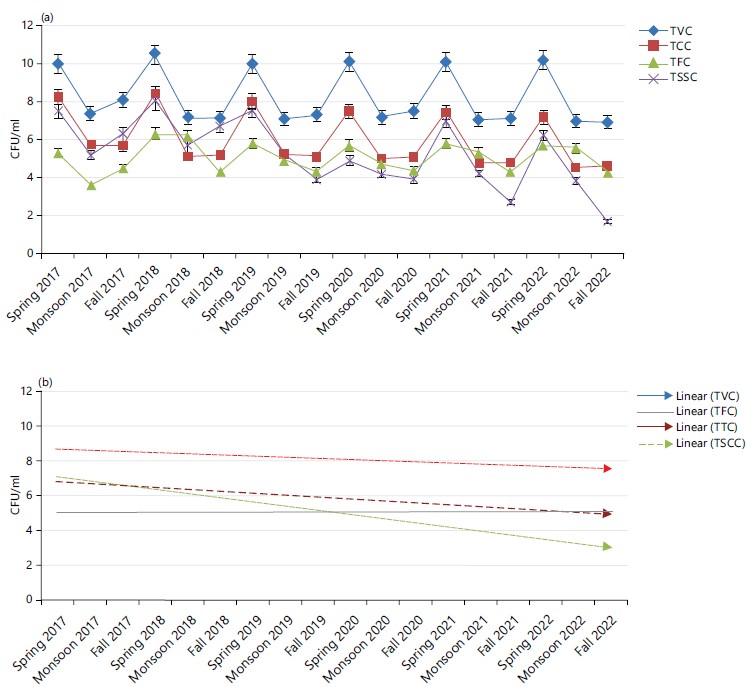
|
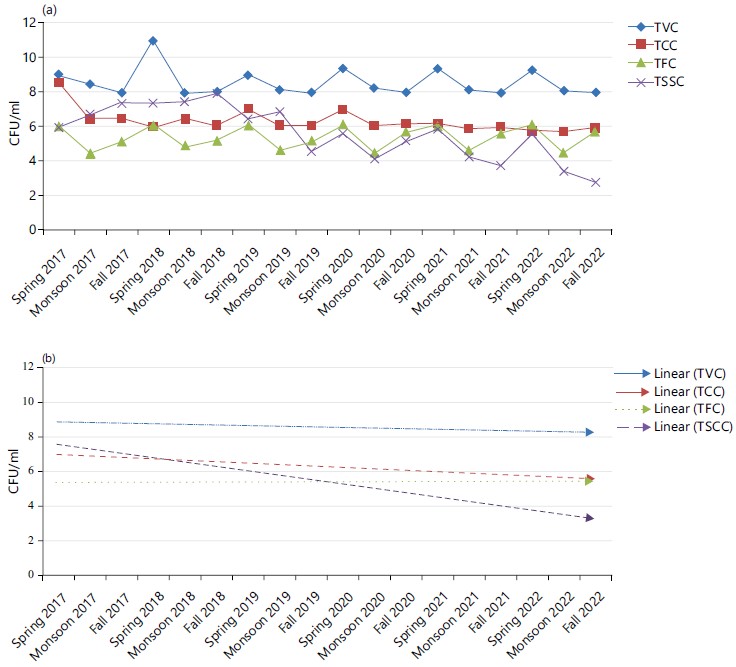
|
The study aimed to observe differences among TVC, TCC, TFC and TSSC at different time seasons and years for all four water reservoir samples. All the bacterial counts were higher during spring but the count reduced during monsoon and again slightly elevated during fall. Burigonga river however showed an exception to this slightly (Fig. 2a, b) and bacterial count remained close throughout all seasons. Turag and Banani rivers showed a high bacterial count in contrast to previous work conducted (Fig. 3a, b). Bacterial count fluctuated highly in the case of these two water bodies with changing seasons.
In the case of the Turag river, TCC and TSSC showed a downward linear forecast trend line where the trend line of TVC and TFC remained constant or upwards (Fig. 1b).
Burigonga River sample showed similar microbial counts in different years with the highest viable count during spring 2018. TVC and TFC showed slightly downward and upward trend lines espectively where the count of Shigella Salmonella and Coliforms are pointing downwards (Fig. 1b).
Banani Lake showed increased microbial load in the year 2017 which could be due to construction work around the Banani Lake in which the lake’s water was blocked in areas that may facilitate the growth of microbes. Trend lines showed a downward trend for future indication of decreased growth of most organisms where TSSC showed a lower rate of a downward trend indicating Salmonella and Shigella count in Banani Lake may persist longer in high concentration.
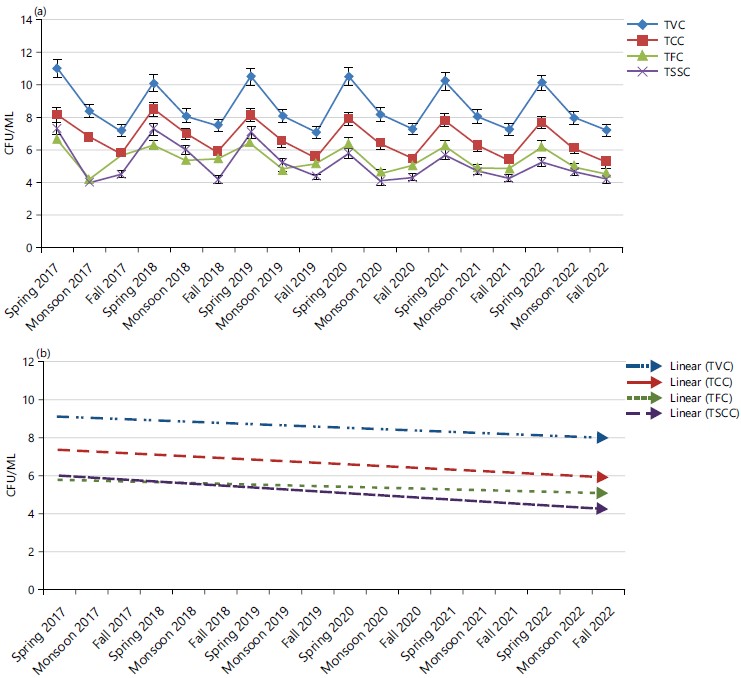
|
The microbial status of Dhanmondi lake revealed a constant trend in the case of TVC where TCC is slightly and TSSC is rapidly declining. On the other hand, increased TFC and upward trendline indicate fecal contamination in the water body in comparison to other reservoirs (Fig. 4a, b).
The overall microbial status of water reservoirs indicates the decreased total viable count in upcoming years may follow current trends. In the case of Turag River and Banani Lake, the microbial count may drop once surrounding constructions are over and larger water content is available. On the other hand, Burigonga and Dhanmondi are showing a stable microbial count trend (Fig. 5).
The current study revealed the predominant presence of several pathogenic and opportunistic pathogens such as Escherichia coli, Enterobacter sp., Klebsiella sp., Salmonella sp., Shigella sp., Staphylococcus aureus, Pseudomonas sp., Acinetobacter sp., Bacillus sp. and Alcaligens faecalis (Table 1). Although, a majority of organisms were present in all cases, some were absent in some cases. Pathogens that outnumber the organisms might be the reason for such a phenomenon.
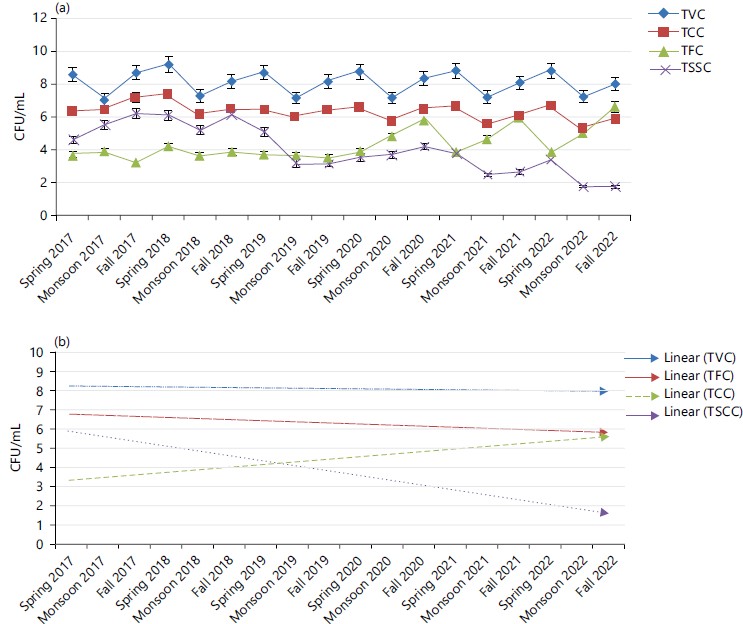
|
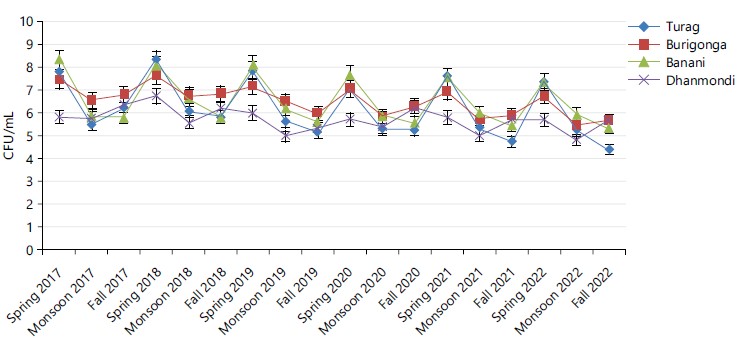
|
| Table 1: | Microorganism isolated from water bodies during different seasons | |||
| Season (Year) | Sample | Isolates |
| Spring (2017) | Turag River | Staphylococcus aureus, Micrococcus sp., Escherichia coli, Salmonella sp., Shigella sp., Enterobacter sp., Pseudomonas sp., Acinetobacter sp. and Proteus sp. |
| Burigonga River | Staphylococcus aureus, Escherichia coli, Bacillus sp., Salmonella sp., Shigella sp., Enterobacter sp., Pseudomonas sp., Acinetobacter sp., Proteus sp. and Klebsiella sp. |
|
| Banani Lake | Staphylococcus aureus, Escherichia coli, Salmonella sp., Shigella sp., Enterobacter sp., Acinetobacter sp., Proteus sp. and Klebsiella sp. |
|
| Dhanmondi | Escherichia coli, Staphylococcus aureus, Salmonella sp., Enterobacter sp., Pseudomonas sp. and Klebsiella sp. |
|
| Monsoon (2017) | Turag River | Staphylococcus aureus, Escherichia coli, Salmonella sp., Shigella sp., Enterobacter sp., Pseudomonas sp. and Proteus sp. |
| Burigonga River | Staphylococcus aureus, Escherichia coli, Shigella sp., Enterobacter sp., Pseudomonas sp., Proteus sp. and Klebsiella sp. |
|
| Banani Lake | Escherichia coli, Salmonella sp., Shigella sp., Acinetobacter sp. and Proteus sp., | |
| Dhanmondi | Staphylococcus aureus, Escherichia coli, Salmonella sp., Enterobacter sp., Pseudomonas sp., Proteus sp. and Klebsiella sp. |
|
| Fall (2017) | Turag River | Staphylococcus aureus, Escherichia coli, Salmonella sp., Enterobacter sp., Pseudomonas sp. and Klebsiella sp. |
| Burigonga River | Staphylococcus aureus, Escherichia coli, Bacillus sp., Salmonella sp., Shigella sp., Pseudomonas sp. and Acinetobacter sp. |
|
| Banani Lake | Staphylococcus aureus, Escherichia coli, Salmonella sp., Enterobacter sp. and Klebsiella sp. | |
| Dhanmondi | Staphylococcus aureus, Escherichia coli, Salmonella sp., Pseudomonas sp., Enterobacter sp. and Klebsiella sp. |
|
| Spring (2018) | Turag River | Staphylococcus aureus, Micrococcus sp., Escherichia coli, Salmonella sp. andShigella sp., Enterobacter sp., Pseudomonas sp., Acinetobacter sp. and Proteus sp. |
| Burigonga River | Staphylococcus aureus, Escherichia coli, Bacillus sp., Salmonella sp., Shigella sp., Enterobacter sp., Pseudomonas sp., Acinetobacter sp., Proteus sp. and Klebsiella sp. |
|
| Banani Lake | Staphylococcus aureus, Escherichia coli, Salmonella sp., Shigella sp., Enterobacter sp., Acinetobacter sp., Proteus sp. and Klebsiella sp. |
|
| Dhanmondi | Escherichia coli, Staphylococcus aureus, Salmonella sp., Enterobacter sp., Pseudomonas sp. and Klebsiella sp. |
|
| Monsoon (2018) | Turag River | Staphylococcus aureus, Escherichia coli, Bacillus sp., Salmonella sp., Shigella sp., Pseudomonas sp. and Acinetobacter sp. |
| Burigonga River | Staphylococcus aureus, Escherichia coli, Salmonella sp., Enterobacter sp., Klebsiella sp., Shigella sp. and Pseudomonas sp. |
|
| Banani Lake | Staphylococcus aureus, Escherichia coli, Salmonella sp., Enterobacter sp. and Klebsiella sp. | |
| Dhanmondi | Staphylococcus aureus, Micrococcus sp., Escherichia coli, Salmonella sp., Shigella sp., Enterobacter sp., Pseudomonas sp., Acinetobacter sp. and Proteus sp. |
|
| Fall (2018) | Turag River | Staphylococcus aureus, Escherichia coli, Salmonella sp., Shigella sp., Enterobacter sp., Acinetobacter sp., Proteus sp. and Klebsiella sp. |
| Burigonga River | Escherichia coli, Staphylococcus aureus, Salmonella sp., Enterobacter sp., Pseudomonas sp. and Klebsiella sp. |
|
| Banani Lake | Staphylococcus aureus, Escherichia coli, Bacillus sp., Salmonella sp., Shigella sp., Enterobacter sp., Pseudomonas sp., Acinetobacter sp., Proteus sp. and Klebsiella sp. |
|
| Dhanmondi | Staphylococcus aureus, Escherichia coli, Salmonella sp., Shigella sp., Enterobacter sp., Acinetobacter sp., Proteus sp. and Klebsiella sp. |
|
| Spring (2019) | Turag River | Escherichia coli, Staphylococcus aureus, Salmonella sp., Enterobacter sp., Pseudomonas sp. and Klebsiella sp. |
| Burigonga River | Staphylococcus aureus, Escherichia coli, Salmonella sp., Enterobacter sp. and Klebsiella sp. | |
| Banani Lake | Staphylococcus aureus, Escherichia coli, Salmonella sp., Pseudomonas sp., Enterobacter sp. and Klebsiella sp. |
|
| Dhanmondi | Staphylococcus aureus, Micrococcus sp., Escherichia coli, Salmonella sp., Shigella sp., Enterobacter sp., Pseudomonas sp., Acinetobacter sp. and Proteus sp. |
|
| Monsoon (2019) | Turag River | Staphylococcus aureus, Escherichia coli, Bacillus sp., Salmonella sp., Shigella sp., Enterobacter sp., Pseudomonas sp., Acinetobacter sp., Proteus sp. and Klebsiella sp. |
| Burigonga River | Staphylococcus aureus, Escherichia coli, Salmonella sp., Shigella sp., Enterobacter sp., Acinetobacter sp., Proteus sp. and Klebsiella sp. |
|
| Banani Lake | Escherichia coli, Staphylococcus aureus, Salmonella sp., Enterobacter sp., Pseudomonas sp. and Klebsiella sp. |
|
| Dhanmondi | Staphylococcus aureus, Escherichia coli, Salmonella sp., Shigella sp., Enterobacter sp., Acinetobacter sp., Proteus sp. and Klebsiella sp. |
|
| Season (Year) | Sample | Isolates |
| Fall (2019) | Turag River | Staphylococcus aureus, Escherichia coli, Salmonella sp., Enterobacter sp., Klebsiella sp. Shigella sp. and Pseudomonas |
| Burigonga River | Staphylococcus aureus, Escherichia coli, Salmonella sp., Enterobacter sp. and Klebsiella sp. | |
| Banani Lake | Staphylococcus aureus, Escherichia coli, Salmonella sp., Shigella sp., Enterobacter sp., Acinetobacter sp., Proteus sp. and Klebsiella sp. |
|
| Dhanmondi | Staphylococcus aureus, Escherichia coli, Salmonella sp., Pseudomonas sp., Enterobacter sp. and Klebsiella sp. |
|
| Spring (2020) | Turag River | Staphylococcus aureus, Micrococcus sp., Escherichia coli, Salmonella sp., Shigella sp., Enterobacter sp., Pseudomonas sp., Acinetobacter sp. and Proteus sp. |
| Burigonga River | Staphylococcus aureus, Micrococcus sp., Escherichia coli, Salmonella sp., Shigella sp., Enterobacter sp., Pseudomonas sp., Acinetobacter sp. and Proteus sp. |
|
| Banani Lake | Staphylococcus aureus, Escherichia coli, Bacillus sp., Salmonella sp., Shigella sp., Enterobacter sp., Pseudomonas sp., Acinetobacter sp., Proteus sp. and Klebsiella sp. |
|
| Dhanmondi | Staphylococcus aureus, Escherichia coli, Salmonella sp., Shigella sp., Enterobacter sp., Acinetobacter sp., Proteus sp. and Klebsiella sp. |
|
| Monsoon (2020) | Turag River | Escherichia coli, Staphylococcus aureus, Salmonella sp., Enterobacter sp., Pseudomonas sp. and Klebsiella sp. |
| Burigonga River | Staphylococcus aureus, Escherichia coli, Salmonella sp., Enterobacter sp. and Klebsiella sp. | |
| Banani Lake | Staphylococcus aureus, Escherichia coli, Salmonella sp., Shigella sp., Enterobacter sp., Acinetobacter sp., Proteus sp. and Klebsiella sp. |
|
| Dhanmondi | Staphylococcus aureus, Escherichia coli, Salmonella sp., Enterobacter sp., Klebsiella sp., Shigella sp. and Pseudomonas |
DISCUSSION
The current study aimed to observe the differences in the count of TVC, TCC, TFC and TSSC and upcoming microbial load based on contamination levels in river and lake waters in three different seasons. The current study managed to clarify that count greatly increased during spring due to decreased water content in water reservoirs and rapid evaporation of water due to dry season; as a result, microorganisms propagate in the remaining water. Microbial count reduces in monsoon and again tends to increase in fall based on the availability of water and rainfall. In Bangladesh, monsoon season begins in mid-May and ends in late October in some years. It consists of extensive rainfall and high humidity, acting as a complex variable that impacts water microbiota21,28.
A great decrease of microbes was observed during monsoon in any water body irrespective of the year which might be because of rainfall that reduces total microbial concentration in the volume of water bodies. In another study, it was found that heterotrophic bacterial load in the river Buriganga, Dhaka, Bangladesh increased in the rainy season27 (July-August) might be due to the runoff31.
Spring prevails from mid-February to mid-April, April being the warmest month. High temperatures along with occasional heavy rainfall might be the reason for the elevated count of indicators and various pathogens as well as the washing out of human, animal and chemical wastes into water bodies. Autumn/Fall begins in August and continues to mid-October, whereas late autumn starts from mid-October to mid-December. In the current study, samples were collected during late Autumn during low temperatures and rainfall. The water level in reservoirs gets concentrated which increases during monsoon increasing bacterial load21,32.
The current study showed the presence of a significant number of indicators and pathogens making the water samples harmful for human consumption. The investigated water reservoirs exceeded the maximum safety limit according to the drinking water quality standard which is 0 CFU/100 mL for fecal coliform (FC), 5 CFU/100 mL for total coliform (TC), 100 CFU/mL for heterotrophic bacterial count and 5 CFU/100 mL for enterococci4,33. As water samples exceeded the quality standard for drinking it makes them unsuitable for drinking. Although, the urban population rarely uses surface water for drinking purposes, they are often used in bathing, washing clothes and utensils, etc.
The guideline for water quality is based on the fecal coliform count. The European Economic Community Council indicates TC count should be 500 CFU/100 mL maximum being 10,000 CFU/100 mL, FC and fecal streptococci count should be 100 CFU/100 mL and no Salmonella is admissible15. According to WHO, FC is <100 CFU/100 mL and FS is <100 CFU/100 mL for primary human use based on water quality standards4. All test samples are poor in quality for drinking and recreational purposes.
Buriganga river exhibited the highest bacterial contamination which correlates with a study conducted in 2009, which showed a significant level of pollution27 and a previous study conducted in Dhaka with changing seasonal variation28. Turag River showed high physicochemical parameters in another study as well as Dhanmondi lake31.
In the current study, a rise in microbial population was observed in the year 2018-19 in comparison to 201628 in the previous study for Turag River and Banani Lake. Construction of Rapid Transit near Turag River and construction around Banani lake caused blockade and reduced water flow. This increased microbial population in a small volume of water caused a high count.
Forecasting for the next two years revealed that in most cases microbial count in water bodies will stay constant and in some cases, it may decrease slightly. A decrease in microbial population may be caused by increased chemical and physical pollutants, low BOD, etc. Situations such as lockdown due to pandemics or flooding may cause a decrease in microbial population as seen from data during the monsoon of 2020.
CONCLUSION
In conclusion, our study provides valuable insights into the impact of seasonal variability on microbial load in water bodies surrounding Dhaka City, Bangladesh. Through systematic monitoring and analysis, we observed significant fluctuations in microbial populations across different seasons. During the monsoon season, microbial load peaked, driven by increased runoff and contamination from various sources. Fecal coliform counts surpassed regulatory limits during this period, indicating potential health risks for the local population. Conversely, microbial load decreased during the dry season but remained elevated compared to international standards. Proper waste disposal and management system should be practiced to reduce pollution of water bodies as well as the environment which in turn will reduce the cases of illness. Further research is warranted to explore the sources and pathways of microbial contamination, as well as the long-term implications for ecosystem health and human well-being. Collaborative efforts between researchers, policymakers and local communities are essential for developing sustainable solutions to address water quality challenges in Dhaka City and similar urban environments worldwide.
SIGNIFICANCE STATEMENT
This research article has substantial significance by addressing critical issues related to water quality, public health, environmental management and climate resilience in Dhaka City, Bangladesh. Its findings are relevant not only for this specific region but also for urban areas facing similar challenges worldwide. This research has the potential to inform policies and practices that enhance the quality of life, reduce health risks and contribute to sustainable urban development.
ACKNOWLEDGMENTS
The authors acknowledge the kind help of Muhammad Tarek, Md. Robiul Islam and Md. Asikuzzaman, Department of Microbiology, Primeasia University.
REFERENCES
- Pathak, S.P., J.W. Bhattacherjee and P.K. Ray, 1993. Seasonal variation in survival and antibiotic resistance among various bacterial populations in a Tropical River. J. Gen. Appl. Microbiol., 39: 47-56.
- Servais, P., G. Billen, A. Goncalves and T. Garcia-Armisen, 2007. Modelling microbiological water quality in the Seine river drainage network: Past, present and future situations. Hydrol. Earth Syst. Sci., 11: 1581-1592.
- Mohamad, Z.A., S.K. Bakon, M.A.J. Jamilan, N. Daud, L. Ciric, N. Ahmad and N.A. Muhamad, 2022. Prevalence of antibiotic-resistant bacteria and antibiotic-resistant genes and the quantification of antibiotics in drinking water treatment plants of Malaysia: Protocol for a cross-sectional study. JMIR Res. Protoc., 11.
- UNICEF and WHO, 2015. Progress on Sanitation and Drinking Water : 2015 Update and MDG Assessment World Health Organization, Geneva, Switzerland, ISBN: 9789241509145, Pages: 80.
- Bogale, G.G., 2020. Hotspots of unimproved sources of drinking water in Ethiopia: Mapping and spatial analysis of Ethiopia demographic and health survey Data 2016. BMC Public Health, 20.
- Mobin, M.N., M.S. Islam, M.Y. Mia and B. Bakali, 2014. Analysis of physicochemical properties of the Turag River Water, Tongi, Gazipur in Bangladesh. J. Environ. Sci. Nat. Resour., 7: 27-33.
- Bitton, G., 2014. Microbiology of Drinking Water: Production and Distribution. John Wiley & Sons, Hoboken, New Jersey, ISBN: 9781118743928, Pages: 312.
- Leclerc, H., L. Schwartzbrod and E. Dei-Cas, 2002. Microbial agents associated with waterborne diseases. Crit. Rev. Microbiol., 28: 371-409.
- Sabae, S.Z., M.M. El-Sheekh, M.A. Khalil, W.A.E. Elshouny and H.M. Badr, 2014. Seasonal and regional variation of physicochemical and bacteriological parameters of surface water in El-Bahr El-Pherony, Menoufia, Egypt. World J. Fish Mar. Sci., 6: 328-335.
- Sabogal, R.I., E. Medlin, G. Aquino and R.J. Gelting, 2014. Sustainability of water, sanitation and hygiene interventions in Central America. J. Water Sanit. Hyg. Dev., 4: 89-99.
- Crowther, J., D. Kay and M.D. Wyer, 2001. Relationships between microbial water quality and environmental conditions in coastal recreational waters: The Fylde Coast, UK. Water Res., 35: 4029-4038.
- Kumar, R. and R.C. Sharma, 2020. Microbial diversity in relation to physico-chemical properties of hot water ponds located in the Yamunotri landscape of Garhwal Himalaya. Heliyon, 6.
- Pandey, P.K., P.H. Kass, M.L. Soupir, S. Biswas and V.P. Singh, 2014. Contamination of water resources by pathogenic bacteria. AMB Express, 4.
- Mahbubul Syeed, M.M., M.S. Hossain, M. Rajaul Karim, M. Faisal Uddin, M. Hasan and R.H. Khan, 2023. Surface water quality profiling using the water quality index, pollution index and statistical methods: A critical review. Environ. Sustainability Indic., 18.
- APHA, AWWA and WEF, 1998. Standard Methods for the Examination of Water and Wastewater. 20th Edn., APHA-AWWA-WEF, Washington, DC, ISBN: 9780875532356.
- Obi, C.L., N. Potgieter, P.O. Bessong and G. Matsaung, 2002. Assessment of the microbial quality of river water sources in rural Venda communities in South Africa. Water SA, 28: 287-292.
- Ramírez-Castillo, F.Y., A. Loera-Muro, M. Jacques, P. Garneau and F.J. Avelar-González et al., 2015. Waterborne pathogens: Detection methods and challenges. Pathogens, 4: 307-334.
- Lemarchand, K., L. Masson and R. Brousseau, 2004. Molecular biology and DNA microarray technology for microbial quality monitoring of water. Crit. Rev. Microbiol., 30: 145-172.
- Fakruddin, M., M.M. Rahaman, M.N. Hossain and M.M. Ahmed, 2017. Induction and resuscitation of Cronobacter sakazakii into viable but non-culturable state at low temperature in water microcosm. Asian J. Biol. Sci., 10: 64-71.
- Djuikom, E., T. Njine, M. Nola, V. Sikati and L.B. Jugnia, 2006. Microbiological water quality of the Mfoundi River watershed at Yaounde, Cameroon, as inferred from indicator bacteria of fecal contamination. Environ. Monit. Assess., 122: 171-183.
- Kay, D., J. Bartram, A. Prüss, N. Ashbolt and M.D. Wyer et al., 2004. Derivation of numerical values for the World Health Organization guidelines for recreational waters. Water Res., 38: 1296-1304.
- Azmuda, N., M. Fakruddin, S.I. Khan and N.K. Birkeland, 2019. Bacterial community profiling of tropical freshwaters in Bangladesh. Front. Public Health, 7.
- Pruss, A., 1998. Review of epidemiological studies on health effects from exposure to recreational water. Int. J. Epidemiol., 27: 1-9.
- van Asperen, I.A., G. Medema, M.W. Borgdorff, M.J.W. Sprenger and A.H. Havelaar, 1998. Risk of gastroenteritis among triathletes in relation to faecal pollution of fresh waters. Int. J. Epidemiol., 27: 309-315.
- Zamxaka, M., G. Pironcheva and N.Y.O. Muyima, 2004. Microbiological and physico-chemical assessment of the quality of domestic water sources in selected rural communities of the Eastern Cape Province, South Africa. Water SA, 30: 333-339.
- Mcbride, G.B., C.E. Salmond, D.R. Bandaranayake, S.J. Turner, G.D. Lewis and D.G. Till, 1998. Health effects of marine bathing in New Zealand. Int. J. Environ. Health Res., 8: 173-189.
- Saha, M.L., M.R. Khan, M. Ali and Sirajul Hoque, 2009. Bacterial load and chemical pollution level of the River Buriganga, Dhaka, Bangladesh. Bangladesh J. Bot., 38: 87-91.
- Sikdar, M.S.S., M. Abony, T. Zerin, A. Banik and S. Datta, 2018. Seasonal variation of bacterial load in river and lake waters of Dhaka City, Bangladesh. Bangladesh J. Microbiol., 35: 116-121.
- Abd Al-Kareem, A.F., K.H. Al-Arajy and K. A. Jassim, 2015. Microbiological analysis on Tigris River water in the selected sites in Baghdad Province, Iraq. J. Environ. Earth Sci., 5: 60-64.
- Chandra, R., S. Singh and A. Raj, 2006. Seasonal bacteriological analysis of Gola River water contaminated with pulp paper mill waste in Uttaranchal, India. Environ. Monit. Assess., 118: 393-406.
- Razzak, N.R.B., A.Z. Siddik and M. Ahmeduzzaman, 2013. Evaluation of water quality of Ramna and Gulshan Lakes. Int. J. Environ. Monit. Anal., 1: 273-278.
- Shultana, S., K.M. Maraz, F. Islam, K.M. Haque and M. Mukul Hossain et al., 2022. Investigation of the water samples of six central rivers of Bangladesh. GSC Adv. Res. Rev., 10: 62-70.
- Baghel, V.S., K. Gopal, S. Diwedi and R.D. Tripathi, 2005. Bacterial indicators of faecal contamination of the Gangetic River system right at its source. Ecol. Indic., 5: 49-56.
How to Cite this paper?
APA-7 Style
Datta,
S., Fakruddin,
M., Abony,
M., Talukder,
B., Shishir,
M.A. (2024). Prognosticating the Impact of Seasonal Variability on Microbial Load in Water Bodies Around Dhaka City, Bangladesh. Asian Science Bulletin, 2(1), 74-84. https://doi.org/10.3923/asb.2024.74.84
ACS Style
Datta,
S.; Fakruddin,
M.; Abony,
M.; Talukder,
B.; Shishir,
M.A. Prognosticating the Impact of Seasonal Variability on Microbial Load in Water Bodies Around Dhaka City, Bangladesh. Asian Sci. Bul 2024, 2, 74-84. https://doi.org/10.3923/asb.2024.74.84
AMA Style
Datta
S, Fakruddin
M, Abony
M, Talukder
B, Shishir
MA. Prognosticating the Impact of Seasonal Variability on Microbial Load in Water Bodies Around Dhaka City, Bangladesh. Asian Science Bulletin. 2024; 2(1): 74-84. https://doi.org/10.3923/asb.2024.74.84
Chicago/Turabian Style
Datta, Suvamoy, Md. Fakruddin, Maruf Abony, Byomkesh Talukder, and Md. Asaduzzaman Shishir.
2024. "Prognosticating the Impact of Seasonal Variability on Microbial Load in Water Bodies Around Dhaka City, Bangladesh" Asian Science Bulletin 2, no. 1: 74-84. https://doi.org/10.3923/asb.2024.74.84

This work is licensed under a Creative Commons Attribution 4.0 International License.




